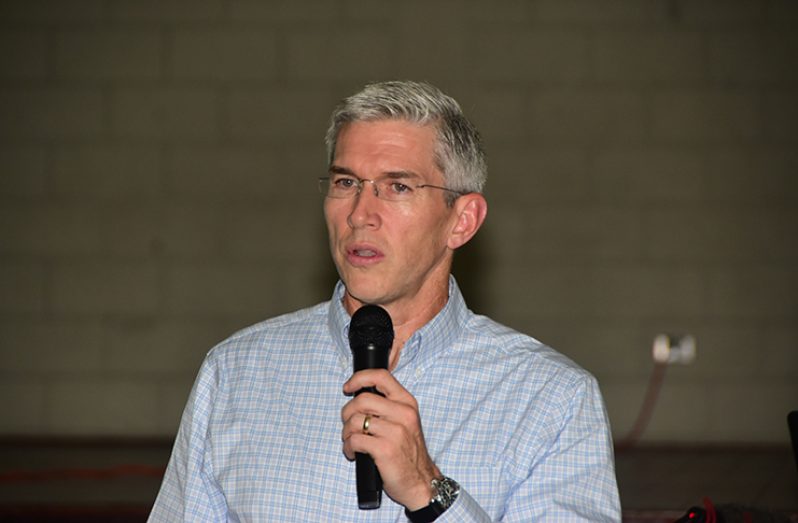With consultation on the Environmental Impact Assessment (EIA) report on Esso Exploration and Production Guyana Limited (EEPGL) ongoing, it has been concluded that the adoption of embedded controls, mitigation measures and management plans and the requirement for emergency response preparedness, the Liza Phase 2 development “is expected to pose only minor risks to the environmental and socio-economic resources of Guyana, while potentially offering significant economic benefits to the residents of Guyana.”
This was disclosed Monday at a public meeting on the EIA for the EEPGL’s Liza Phase 2 Project, held at the Marian Academy, Carifesta Avenue, Georgetown. An assessment of the cumulative impact assessment shows that the project’s contribution to cumulative impacts will be limited by its distance offshore, the distance between separate EEPGL activities and the small number of non-EEPGL projects or activities, either operating or currently planned to be operating offshore Guyana.

Other EEPGL development and exploration projects, the replacement of the Demerara Harbour Bridge, Guyana’s Mariculture project and external drivers, including natural hazards/ climate change and commercial fishing, were all considered in the assessment.
The proposed Liza Phase 2 development project is located approximately 183km offshore with up to 33 subsea development wells being dug. Oil transported by pipes from the said wells to a large ship– a Floating Production, Storage and Offloading vessel (FPSO).
The FPSO will process, store and offload oil to oil tankers and those tankers will transport the oil to markets. Onshore facilities will be providing logistical support. The project will see approximately 600 workers at peak during each drilling and installation stages; about 140 offshore workers during production operations; and about 150 onshore workers providing shore-based and marine logistics support.
In examining the potential impacts, the consultants noted that there are negligible impacts on physical resources (air quality, marine geology and sediments, marine water quality), there would be no impact on coastal biological resources, minor impacts on some marine biological resources (special status fish and bird species), moderate impacts on marine mammals, minor impacts on some socio-economic resources and largely positive impacts on socio-economic conditions and employment.
On the question of unplanned events such as oil spills, Todd Hall of Environment Resources Management (ERM), a consultant who worked on the EIA, said large oil spills are considered unlikely

because of the extensive preventive measures employed by EEPGL.
He explained that because of the well design, which includes the use of well control equipment, the use of FPSO with double hull protection, the use of support tugs to aid conventional tankers in maintaining station during approach, offloading and departure, along with the use of a class certified floating double carcass hose system with emergency disconnect controls, drilling fluids to control pressures within the well (s), load monitoring and leak detection systems during the FPSO offloading and the training of personnel coupled with proficiency drills will ensure readiness for spill response and well control.
He estimates through studies that the only potential for coastal impacts associated with an unmitigated Tier 111 loss of well control, which he said is very rare, is during the ‘winter period’. Some 5 to 7 per-cent probability of an unmitigated oil spill reaching Guyana’s coast, Todd added while noting via the report that the fastest time oil could reach Guyana’s coast would be 5-10 days.
During ‘summer time’, he noted that an unmitigated spill would not reach shore; it is expected to remain 100km off Guyana’s coast.
A member of the audience, Fitzgerald Yaw, asked whether any provision has been made for EEPGL to set aside a fund that can be regularly drawn down so that if there is an oil spill, funding will not be an issue.
Rod Henson, EEPGL’s Country Manager, noted that no fund has been established for such a purpose but noted that measures are in place to ensure that in the event there is an oil spill, action is taken readily.
He reminded that there are laws and regulations which speak to such eventualities. It is expected that should there be an oil spill, response would begin within hours. “We would be responding in a matter of hours, in an instant like that,” he told attendees of the public forum.
Dr Janet Bulkan, who participated in Monday’s public forum, questioned whether after the expected 20 year lifespan of the Liza Phase 2 project, the responsibility of mobilisation and clean-up activities, if any untoward incident such as an oil spill were to happen, would be transferred to the state.
Henson, in response, sought to assure that his company places special emphasis on prevention and noted that at the end of the life of the field, the field would be properly decommissioned and wells abandoned.
“Might we be liable as a country if Caribbean countries then sue us for potentially messing up their waters?” asked Bulkan. In response, the EEPGL Country Manager made it clear that if his company is found liable in any such circumstance, it would have to pay.
“At the end of the day, we would enact procedures we already have in place for spill management,” he stated.
Meanwhile, Executive Director of the Environmental Protection Agency (EPA), Khemraj Parsram, noted that trans-boundary liability, “Discussions are being held with regard to agreements and partnerships with countries like Trinidad…those discussions are ongoing and we are not ready to present the results of that.”
Several questions were asked in light of the recent oil spill in the Gulf of Paria, Trinidad and Tobago, and according to Henson, Guyana is prepared to deal with any such eventuality. Consultations on the EIA report submitted for EEPGL’s Liza Phase 2 Development Project will also be conducted in Regions 1, 2, 3, 5 and 6.



.jpg)








